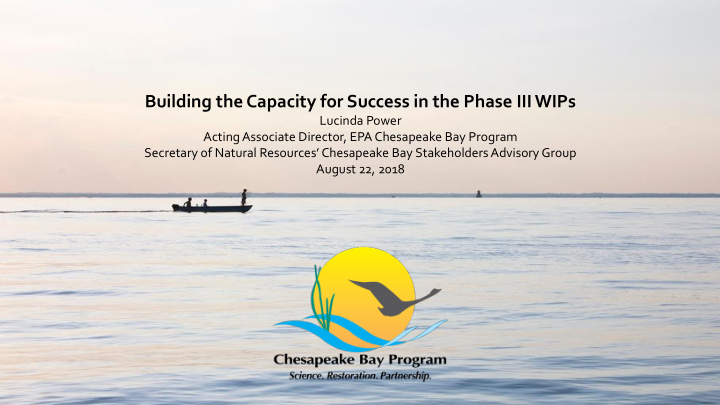



Building the Capacity for Success in the Phase III WIPs Lucinda Power Acting Associate Director, EPA Chesapeake Bay Program Secretary of Natural Resources’ Chesapeake Bay Stakeholders Advisory Group August 22, 2018
WE ARE SEEING REAL BAY AND WATERSHED RESPONSES
Percent of Goal Achieved by Jurisdiction & Watershed-wide 4
CB Watershed Nitrogen Loads-Goals by Jurisdiction 350 300 250 Millions of Pounds 2017 Interim Target 200 2025 Planning Target 150 100 50 0 1985 2009 2017 NY PA DE MD DC VA WV 5
CB Watershed Nitrogen Loads-Goals by Source 350 300 250 Millions of Pounds 2017 Interim Target 200 2025 Planning Target 150 100 50 0 1985 2009 2017 Agriculture Urban Runoff Wastewater+CSO Septic Forest+ 6
Overview EPA released its final expectations for the Phase III WIPs on June 20, 2018 to account for the next seven years of implementation of the 2010 Bay TMDL, as well as to factor in new science and information resulting from the Bay TMDL’s midpoint assessment.
CBP Partnership Role These Phase III WIP expectations went through thorough Partnership review prior to its interim release in January 2017 and final release in June 2018 . Although this document is being released by EPA, many of these expectations are Partnership driven and reflect Partnership priorities and PSC decisions. Through these expectations, the Partnership reaffirmed its commitment to have practices and controls in place by 2025 to meet applicable water quality standards in the Chesapeake Bay.
Final Phase III Planning Targets
1 6 Include a narrative strategy in the Phase III WIPs that describes the jurisdictions current action plans and strategies to address climate change, as well as the jurisdiction-specific nutrient and sediment pollution loadings due to 2025 climate change conditions, while incorporating local priorities and actions to address climate change impacts.
Open Water Attainment Status (2014-2016) Chickahominy River To prioritize segments we can identify tidal segments currently out of attainment, quantify how far away they are from attainment, and determine if they are getting better or worse over time Chickahominy River Segment- shed
Open Water Attainment Status (2014-2016) Chickahominy River Segment-shed To target efforts we can look up into the segment-shed to see where the highest loading areas are (2017 Progress), but also to identify areas where a higher proportion of local load makes it to the tidal segment (delivery factors from Phase 6) 2017 Progress Delivery factors Portion of the watershed with higher loads and more efficient delivery of nitrogen
Open Water Attainment Status (2014-2016) In a few months, we will be able to generate maps showing the most influential areas of the watershed for any segment and know the relative infulence of different basins on water quality in the segment Basin Contribution Chester River Tidal Fresh Upper Eastern Shore
Open Water Attainment Status (2014-2016) In a few months, we will be able to generate maps showing the most influential areas of the watershed for any segment and know the relative infulence of different basins on water quality in the segment Basin Contribution Chester River Tidal Fresh Upper Eastern Shore
• Achieve federal facility targets established in 2015, or however modified to align with Phase III WIP local area planning goals, by 2025. • Establish new targets for new or upgraded facilities as part of the jurisdictions’ local planning goals development. • Report annual BMP progress to the jurisdictions and EPA using tools provided by the jurisdictions that are compatible with requirements for NEIEN. • Develop two-year programmatic and two-year BMP implementation milestones .
Closing As a partnership, we need to recognize the good work and progress we’ve made in meeting our water quality commitment s, while knowing that additional effort is needed to get us to the 2025 goals. We have a shared understanding of how much farther we need to go , what’s needed – both through regulatory and voluntary means – to get us there, and what resources are key to making a demonstrable difference at the state and local levels. EPA looks forward to our continued collaboration with each of the seven Bay watershed jurisdictions as they develop and implement their Phase III WIPs, and EPA will continue to support these efforts through technical assistance, funding, facilitation services, and other resources.
http://www.chesapeakebay.net/groups/group/water_quality_goal_ implementation_team http://cast.chesapeakebay.net/ http://www.chesapeakeprogress.com/clean-water#water-quality
Lucinda Power Acting Associate Director U.S. EPA Chesapeake Bay Program Office 410-267-5722 power.lucinda@epa.gov www.chesapeakebay.net www.epa.gov/chesapeakebaytmdl
Recommend
More recommend